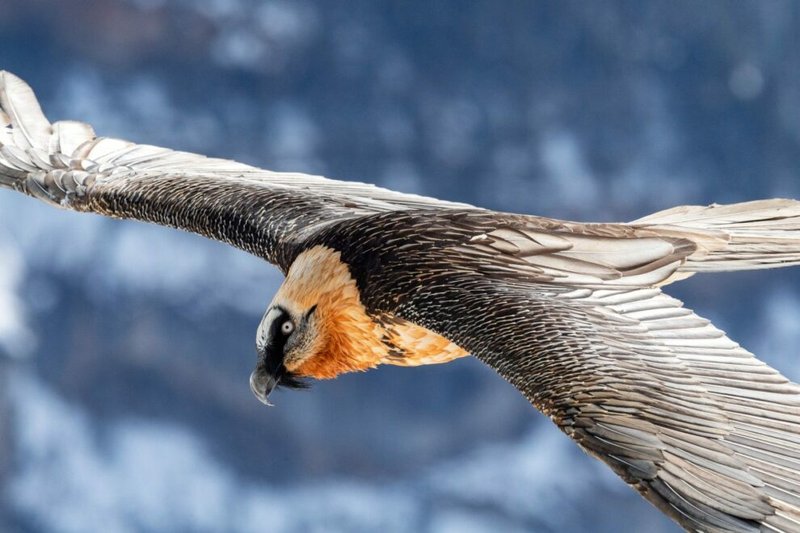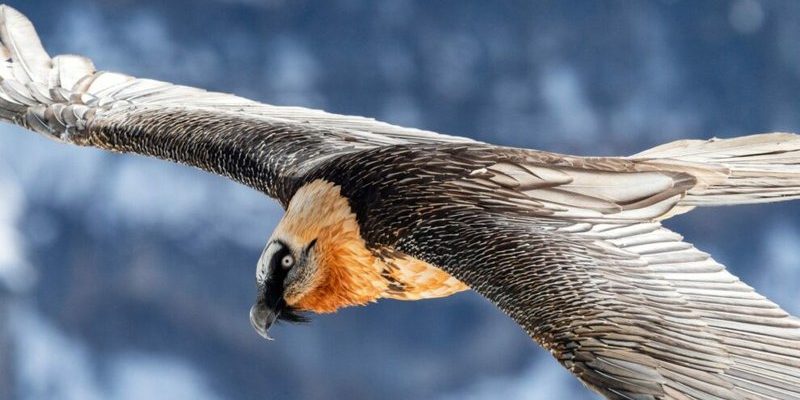
Imagine living somewhere high up, where the air is thin and the landscape is rugged. Sounds tough, right? But the bearded vulture embraces this, gliding on the winds and mastering the art of survival. Through a series of clever adaptations, this bird has turned its mountainous home into a buffet of opportunities. Let me explain how these adaptations help the bearded vulture thrive against the odds.
Physical Adaptations: Built for the Mountains
The physical traits of a bearded vulture are fascinating and tailored for its lifestyle. First off, it’s got a huge wingspan—sometimes exceeding 9 feet! This allows it to soar effortlessly in search of food, covering vast distances with minimal energy. Its strong, curved beak is perfect for breaking down bones, which is a unique part of its diet. Unlike other vultures that primarily feast on flesh, the bearded vulture has evolved to extract the nutrients from bones, allowing it to survive in conditions where other scavengers might struggle.
And let’s not forget about its feather coloration. The bearded vulture has striking dark and light feathers that help it blend into the rocky mountain backdrop. This camouflage is essential for both hunting and avoiding predators. When you see one soaring high above the Alps or Himalayas, it’s hard not to be in awe of how well it fits into its environment.
Unique Adaptations for Bone Consumption
What sets the bearded vulture apart is its fascinating approach to meals. Instead of just eating bones like a regular dinner, this bird has a clever trick up its sleeve. It drops large bones from great heights, shattering them on the rocks below. This method not only makes the bones easier to access but also allows the vulture to eat the nutrient-rich marrow inside. It’s like having a hammer and chisel at its disposal!
This unique feeding strategy is one of the reasons bearded vultures are often referred to as “bone vultures.” With a diet primarily consisting of bones, they’ve perfected this technique, allowing them to extract essential nutrients that most other scavengers overlook. What a clever way to ensure survival!
Behavioral Adaptations: Mastering the Art of Flight
When it comes to navigating their mountainous homes, bearded vultures exhibit impressive behavioral adaptations. For starters, their soaring ability isn’t just for show. They use thermal updrafts—rising currents of warm air—to help them gain altitude with minimal effort. This means they can scout for food over large areas without tiring themselves out.
Additionally, bearded vultures are known for their social structures. They tend to form monogamous pairs and often display complex social behaviors. These relationships help them protect their territory and raise their young, ensuring the next generation has the skills needed to thrive. It’s like a little community of survivalists, supporting one another in a tough environment.
Territory and Nesting Practices
Nesting is a crucial part of a bearded vulture’s life. They typically choose ledges on cliffs or high rocky outcrops, where they can build a nest far from terrestrial predators. This strategy also provides a clear view of the surrounding area, making it easier to spot potential threats. Honestly, it’s a smart move.
Once they nest, these birds can often return to the same site year after year. They’re great at maintaining their homes, which can grow quite large over time. Nesting in remote, hard-to-reach spots not only keeps them safe but also ensures they can raise their young away from the hustle and bustle of other animals.
Feeding Habits: The Art of the Scavenger
Feeding is not just about finding food; it’s an art for the bearded vulture. They are intelligent birds that exhibit remarkable foraging skills. Using keen eyesight, they can spot carcasses from miles away. Once they locate a potential meal, they often wait patiently for other scavengers to break into it before swooping in to claim their share—or, more commonly, their bones.
They’ve also learned to follow other predators, like wolves and lions, to take advantage of their hunting efforts. Imagine being savvy enough to let others do the hard work while you reap the benefits. The bearded vulture has this down to a science!
Seasonal Changes and Diet Variations
As the seasons change, so do the feeding habits of the bearded vulture. In winter, they may rely more on carrion due to fewer available prey animals. However, they’re not picky eaters. The adaptability in their diet means they can switch things up based on what’s available. In spring and summer, they often find more fresh carcasses, which can contribute additional nutrients.
This ability to adjust their diet based on seasonal availability is crucial for their survival in harsher climates. If one food source becomes scarce, they’re able to pivot and look for alternatives.
Conservation Challenges: Navigating a Changing World
Unfortunately, not everything is smooth sailing for bearded vultures. Their populations face significant challenges due to habitat loss and poisoning. As human activity increases in mountainous areas, suitable nesting and feeding sites become harder to find. This is especially concerning for a species that requires such specific environments to thrive.
Additionally, poisoning from agricultural practices can pose a severe threat. The use of toxic substances to control livestock predation can unintentionally harm vultures, as they may consume contaminated carcasses. It’s a stark reminder of how interconnected ecosystems are and how human actions can have far-reaching implications.
Conservation Efforts and Success Stories
Despite these challenges, various conservation efforts are helping to stabilize bearded vulture populations. Organizations across Europe and Asia have been working tirelessly to monitor and protect these birds. Nesting sites are being safeguarded, and there are initiatives aimed at educating local communities about the importance of vultures in the ecosystem.
Some areas have even seen successful reintroduction programs where captive-bred vultures are released back into the wild. These efforts serve as a hopeful reminder that with commitment and action, we can help ensure that bearded vultures continue to soar in our skies for generations to come.
The Future of Bearded Vultures: What Lies Ahead
So, what does the future hold for the bearded vulture? It really comes down to ongoing conservation efforts and a shift in how humans interact with these majestic birds. With greater awareness about their importance in the ecosystem, there’s potential for positive change.
As stewards of our planet, we all play a role in safeguarding the habitats of creatures like the bearded vulture. Protecting these landscapes not only benefits the vultures but also preserves the rich biodiversity of our world. Here’s the thing: every small action counts, whether it’s supporting local conservation groups or simply spreading awareness about these magnificent birds.
In conclusion, the bearded vulture’s remarkable adaptations showcase nature’s incredible ingenuity. From their unique feeding habits to their strategic nesting, every aspect of their life is a testament to resilience and adaptability. As we look towards the future, let’s ensure that these magnificent birds continue to inspire us with their grace and tenacity, soaring high above the mountains we admire.

